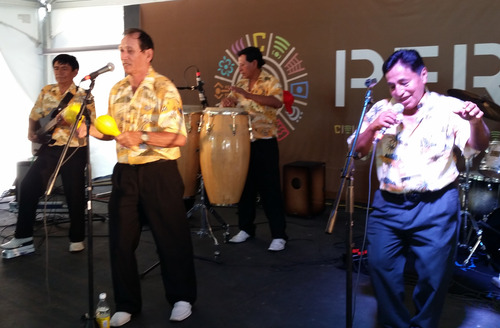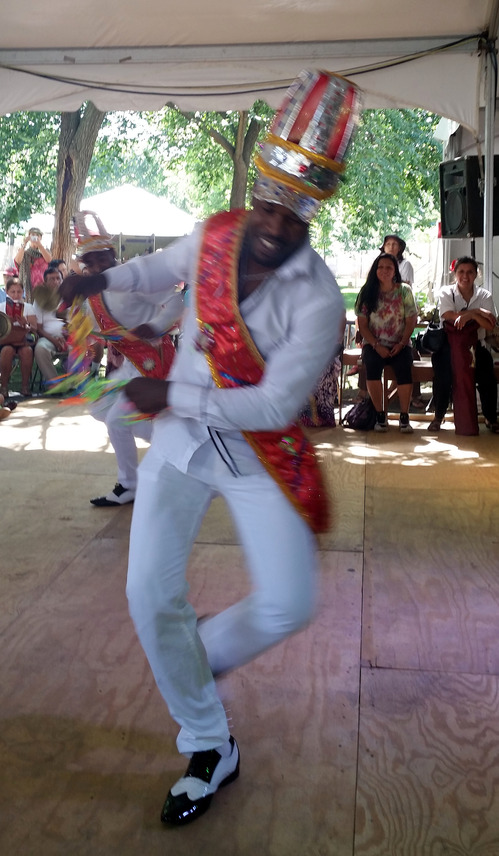When most Americans think of Peruvian music, they think of the high Andes Mountains’ Quechuan music, marked by the fluttery sound of the bamboo zamponas pipes, the trebly, 20-string miniature guitar known as the charango, the bombo drum, and the recorder-like quena flute. This style was best exemplified by the great bands Inti-Illimani and Urubamba, the latter of which accompanied Simon & Garfunkel on “El Condor Pasa.” The music’s worst representatives are the bane of New York subway riders to this day.
But there’s a lot more to Peruvian music than that, as this year’s Smithsonian Folklife Festival in Washington D.C. proves. No zamponas were to be seen, but there were plenty of cajons. This Peruvian invention, a hollow box on top of which the musician sits, has become a favored rhythm instrument throughout the world. Portable and easy to construct from leftover plywood, the cajon became a favorite of Afro-Peruvians who wanted to capture the rippling syncopation of African polyrhythms without overwhelming the delicacy of the nation’s folk musics. It’s evidence of the syncopated rhythms that dominate the nation’s coasts and the selva, the jungle that surrounds the mountains.
In the capital city of Lima and on the dry lowlands of southern Peru, a large population of former African slaves has created the nation’s most popular homegrown sound—Afro-Peruvian music. And in the country’s northeastern corner, where the Amazon River is already flowing through the jungle before it ever gets to Brazil, the locals have married rumbling drums and chirping electric guitars into a sound called selva-rock. Terrific examples of both were on display at this year’s Smithsonian Folklife Festival in the shadow of the scaffolding-encased U.S. Capitol Dome.
The Folklife Festival was launched by the Smithsonian Institution in 1967 and has since offered free demonstrations of music, dance, crafts, and cooking from around the U.S. and the wider world during the last week in June and the first week in July. At its height in the ‘90s, each festival presented four themes: a U.S. state, a foreign country, a profession (such as carpentry or lawyering) and an aspect of folklore research. It produced a handsome paperback book on each year’s themes that was sold at cost.
The result was a thrilling extravaganza for residents of the Baltimore-Washington area and for tourists who timed their travel just right. The festival took one into the secret locations a lone tourist might never find: a Santeria voodoo ceremony in Haiti, a Cajun dance hall in Louisiana or a slack-key guitar party in Hawaii. But with shrinking arts funding and battles with the National Park Service over use of the Mall’s lawn, the 39th annual festival has been reduced to no book and one theme: Peru. But I heard more and better Peruvian music on the festival’s opening day last Wednesday than I did during my two-and-a-half-week visit to Peru in 2004.
I heard, for example, two of Peru’s most legendary acts, one barely known in North America and the other completely unknown for all practical purposes. Eva Ayllon is one of South America’s biggest stars, nominated six times for Grammy awards. She’s the Aretha Franklin of two major genres—musica criolla and Afro-Peruvian lando—although her big alto voice and bawdy good humor suggest a better analogy in Etta James. Los Fabulosos Wembler’s, the leaders of selva-rock, have taken the music from their jungle hometown of Iquitos to Lima, Brazil, and even Europe.
Ayllon took the headlining evening slot on the festival’s first day and delivered a set that had the many Peruvian immigrants on the grass lawn sighing or shouting with pleasure at each opening line to her hits. Now 59 years old, Ayllon squeezed into a glittery purple dress with her frizzy dark hair falling over her shoulders. She was still in good voice, crooning romantically when the song required and adding lusty percussive accents when needed.
As such, she demonstrated the mix of Spanish, African, and Quechuan elements that make Peruvian music so distinctive. The Quechuan culture of Andean Indians (which include many tribes in addition to the Incas) is unlike anything anywhere else, but much of Peru’s population is Spanish, African or Creole—and these cultures play just as important a role. Ayllon’s acoustic guitarist, for example, played flamenco phrases at times, contrasted by the electric bassist’s funky bottom and bridged by the singer’s graceful fluidity. Additionally, her son Carlos was one of three percussionists who played congas, bongos, and the cajon.
Tutuma, an all-star band of Afro-Peruvian musicians at this year’s festival, boasted five percussionists, and at one point each of the five was sitting on his own cajon, slapping out a dizzying array of overlapping rhythms, sometimes diverging and sometimes converging. Four of these drummers donned orange-satin sashes and tall hats that formed a sequined silver cage around red netting, while their black-and-white wingtip shoes banged out tap-dance rhythms. Soon they were challenging each other to tap solos in a cutting contest.
Like Ayllon’s, however, this group also included a virtuoso acoustic guitarist in Felix Arguedas Caycho and a big-voiced female singer in Rosario Goyoneche Narciso, two performers who could balance the push-and-pull African bottom with a more lyrical Spanish/Quechuan top. Narciso, a barefoot woman with a long, dark ponytail and orange-and-blue caftan, lacked Ayllon’s charisma but possessed a similar voice and her spellbinding ballads offered a telling contrast to the frenetic dance numbers.
Los Fabulosos Wemblers were also percussion-heavy, as the classic rock ‘n’ roll format of singer, guitarist, bassist, and drummer was supplemented by timbales, congas, and maracas. The group was founded by the five Sanchez-Casanova brothers when they were all teenagers in the early ‘70s in the Amazon city of Iquitos. They soon became popular at home and then up and down the river with their uncanny blend of Anglo-American rock ‘n’ roll wed to the indigenous music of the jungle.
Three of the brothers are still in the band—Jair on lead vocals, Alberto on electric guitar and Gelner on timbales. Alberto proved to have an uncanny ability to take the vocal, call-and-response melodies of the local tribes and turn them into amplified riffs that proved quite difficult to get out of one’s head. His tone mimics the overloaded reverb of Dick Dale’s surf-rock instrumentals and the cheap, bleating electric organs of Sam the Sham and the Pharaohs or the Sir Douglas Quintet. To this fusion of North American rock and jungle chants were added the cumbia rhythms of nearby Colombia with intoxicating results.
Dressed in matching white shoes and yellow beach shirts illustrated with palm-tree islands, the seven short, stocky men all devoted themselves to the hypnotic effect of repeating motifs with slight alterations. They are of Ayllon’s generation, but like her have held up well long after their peak years. Jair’s tenor voice is still a compelling instrument, radiating a contagious joy, and the four percussionists never get in each other’s way as they keep the rhythm tumbling ever forward. Like the early surf-rock and garage-rock that it borrows from, this selva-rock is mesmerizing not despite its simplicity but because of its simplicity, executed perfectly.
The best costumes at this year’s festival were worn by the 15 representatives from the Fiesta de la Virgen del Carmen de Paucartambo. Paucartambo is a mountain town in southern Peru known for this summer holiday when much of the town dresses up in elaborate sequined satin costumes, trailing cloth strips and masks of either wire mesh or papier-mâché. The four musicians and 11 maskers gave a half-hour sample of the dances and satirical skits (featuring the humiliation of a big-nosed authority figure dressed like a Spanish noble). This would be more powerful in the town square, of course, but it was plenty impressive on the National Mall.
Danza Sarawja was a Quechuan sextet of four female dancers and two male charango players, dressed similarly in flat-brim hats full of flowers and pink woven blankets worn as shawls. All six spun around and around as they chanted the same folk song till they seemed intoxicated with dizziness. Like some folk traditions such as American-Indian pow-wows and Sacred Harp gospel singing, this one was designed more for participants than for spectators.
By contrast, Los Fabulosos Wemblers, Ayllon, and Susana Baca (who headlined the festival’s second day as Ayllon’s successor as queen of Afro-Peruvian music) all have the show-biz savvy to keep spectators entranced. They remind us that the distance between a culture’s amateur folk musicians and professional entertainers is not as far as some on each side of the gap would like to pretend.


